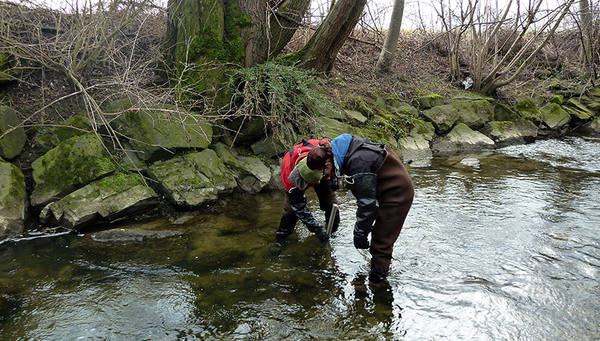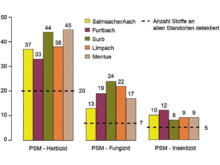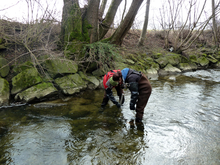News Detail
Cocktail of Pesticides in Swiss Rivers
March 5, 2014 |
This is the first time that such a thorough investigation into the presence of pesticides in Swiss water bodies has been undertaken. In collaboration with five Cantons, Eawag was commissioned by the Swiss government to test for every soluble synthetic plant protection product and biocide in five medium-sized rivers. The specialist journal Aqua & Gas has today published the results in its no. 3/2014 issue. Media professionals can order the full article in pdf format from medien@eawag.ch.
Primarily plant protection products
The main aim of the study carried out on the Salmsacher Aach (TG), Furtbach (ZH), Surb (AG), Limpach (SO) and Mentue (VD) rivers was to find out how many different pesticides are present in these waters. Of the 300 or so permitted and analytically detectable active substances, 104 were found in the rivers, and 82 of these were plant protection products. Thanks to the new, comprehensive data, it can be demonstrated that a significant proportion of current pesticide pollution can be attributed to plant protection products used in agriculture.
High combined concentration levels
The total combined concentration level of pesticides was higher than 1µg/L in 78% of the samples. It is not possible to make a general pronouncement on what the implications of this are for water quality and the effect on aquatic organisms, but the researchers who were involved in the project drew comparisons with the blanket standard of the Swiss Water Protection Ordinance (a maximum of 0.1µg/L per individual substance) and the toxicology-based water quality criterion for chronic pollution (CWQC). They found that 40 substances proved problematical: 21 pesticides exceeded the limit set by the Ordinance, nine substances were over the CWQC limit, and 10 exceeded both. All of the rivers monitored – which were entirely typical for the Swiss Plateau – were thus shown to have a significant level of pollution with a very wide range of pesticides during the monitoring period of March to July. There is justifiable concern that this will have a detrimental effect on aquatic organisms.
There are two particularly problematic issues here:
- Each sample was found to contain, on average, 40 substances. Even if the concentration level of each one of these substances were below the ecotoxicological water quality criterion on its own, there is a real concern that aquatic organisms will be adversely affected by these pesticide cocktails.
- Many of the substances proved to be present in concentrations of over 0. 1µg/l, and in certain cases even over 1µg/l. This is high, given the fact that the measurements were made using composite samples taken over a period of two weeks. The researchers concluded that there must be short-term spikes in concentration levels that are a great deal higher – indeed, well over their threshold values at which they begin to have an acute toxic impact.
Need for a differentiated risk-assessment approach and provisions
Prof. Juliane Hollender, Head of the Department for Environmental Chemistry at Eawag, and the author of the study, was surprised by the new data: “Swiss waters are apparently not quite as clean as they are always made out to be”, she says, although, with its almost complete ability to detect all pesticides, the study has made significant progress in exposing the active substances which pose the greatest threat. These, she says, can now be monitored more specifically, or even possibly restricted in terms of their use. In addition, it is becoming ever clearer that it is not only testing of individual substances that is needed, but also a risk assessment of their combined toxicity.
Article (in German, with a summary in French):
Over 100 pesticides in watercourses; NAWA (National Monitoring of Surface Water Quality) Special Programme reveals high level of pesticide pollution of Swiss watercourses (Über 100 Pestizide in Fliessgewässern; Programm NAWA Spez zeigt die hohe Pestizidbelastung der Schweizer Fliessgewässer auf). Irene Wittmer, Christoph Moschet, Jelena Simovic, Heinz Singer, Christian Stamm, Juliane Hollender (all from Eawag); Marion Junghans (Ecotoxicology Centre, Eawag-EPFL); Christian Leu (FOEN); Aqua & Gas No. 3/2014; p. 32ff.
Anzahl gefundener Herbizide, Fungizide und Insektizide pro Untersuchungsstation (als Pflanzenschutzmittel sowie doppelt, als Pflanzenschutzmittel und Biozid zugelassene Wirkstoffe).





